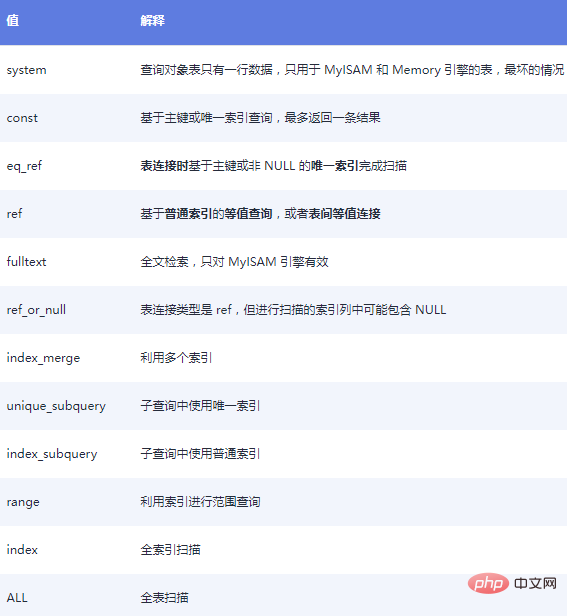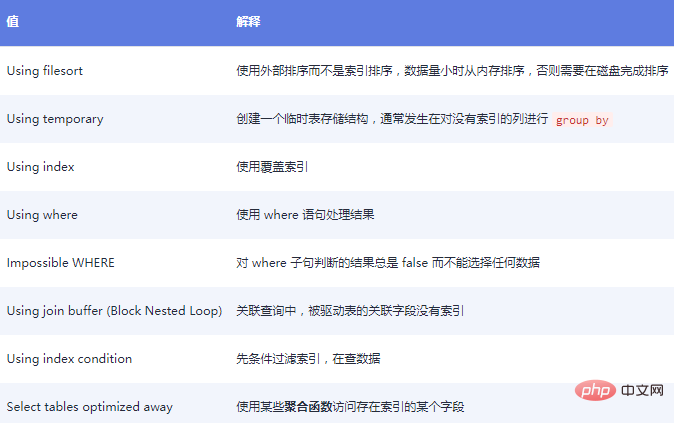Summary and sharing of mysql slow query optimization ideas
This article brings you relevant knowledge about mysql, which mainly introduces issues related to slow query optimization, including using slow query logs to locate slow query SQL and analyzing slow query through explain. Query SQL and modify SQL so that SQL can be indexed as much as possible. Let’s take a look at it together. I hope it will be helpful to everyone.

Recommended learning: mysql video tutorial
1 Slow query optimization ideas
When a slow query occurs , the optimization idea is:
Use slow query logs to locate slow query SQL
Use explain to analyze slow query SQL
Modify SQL and try to make SQL indexed
2 Slow query log
MySQL provides a function-slow query log, which will record queries SQL whose time exceeds the specified time threshold is recorded in the log, allowing us to locate slow queries and optimize the corresponding SQL statements.
First check the global variables related to slow query in MySQL:
mysql> show global variables like '%quer%'; +----------------------------------------+-------------------------------+ | Variable_name | Value | +----------------------------------------+-------------------------------+ | binlog_rows_query_log_events | OFF | | ft_query_expansion_limit | 20 | | have_query_cache | YES | | log_queries_not_using_indexes | OFF | | log_throttle_queries_not_using_indexes | 0 | ========================================================================== | long_query_time | 10.000000 |【1】慢查询的时间阈值 ========================================================================== | query_alloc_block_size | 8192 | | query_cache_limit | 1048576 | | query_cache_min_res_unit | 4096 | | query_cache_size | 16777216 | | query_cache_type | OFF | | query_cache_wlock_invalidate | OFF | | query_prealloc_size | 8192 | ========================================================================== | slow_query_log | OFF |【2】慢查询日志是否开启 | slow_query_log_file | /var/lib/mysql/Linux-slow.log |【3】慢查询日志文件存储位置 ========================================================================== +----------------------------------------+-------------------------------+ 15 rows in set (0.00 sec)
Here we mainly focus on three variables:
long_query_time, the time of slow query Threshold, in seconds. If the execution time of a SQL statement exceeds this value, MySQL will determine it as a slow query.
slow_query_log, whether the slow query log function is turned on, is turned off by default. After it is turned on, Record slow query
slow_query_log_file, the storage location of the slow query log file
The slow query log function is turned off by default, so we need to enable it Function
# 开启慢查询日志 mysql> set global slow_query_log=ON; Query OK, 0 rows affected (0.00 sec) # 设置慢查询时间阈值 mysql> set long_query_time=1; Query OK, 0 rows affected (0.00 sec)
After setting like this, MySQL will lose these configurations when it restarts, and they need to be modified in the configuration file to be permanently effective.
3 explain
We can use explain to analyze the execution of SQL statements, for example:
mysql> explain select sum(1+2);
The execution results are as follows, you can see that there are many fields

We mainly look at some important fields:
select_type represents the query type of the query statement, including simple queries, subqueries, etc.
table represents the query table, which may not necessarily exist. It may be a temporary table obtained in this query.
type represents the retrieval type, use the full table Scan, index scan, etc.
possible_keys indicates the index columns that may be used
keys indicates the index columns actually used in the query, which are optimized by the query The processor decides
3.1 select_type field

3.2 type field
For the InnoDB storage engine, the type column is usually all or index.
Regarding the value of the type field, the execution performance of the corresponding SQL gradually becomes worse from top to bottom.

3.3 extra field

4 Slow Query example
Prepare data, data table structure:
create table user_info_large ( `id` BIGINT UNSIGNED NOT NULL AUTO_INCREMENT COMMENT '主键', `account` VARCHAR(20) NOT NULL COMMENT '用户账号', `name` VARCHAR(20) NOT NULL COMMENT '用户名', `password` VARCHAR(20) not null COMMENT '用户密码', `area` VARCHAR(20) NOT NULL COMMENT '用户地址', `signature` VARCHAR(50) not null COMMENT '个性签名', PRIMARY KEY (`id`) COMMENT '主键', UNIQUE (`account`) COMMENT '唯一索引', KEY `index_area_signture` (`area`, `signature`) COMMENT '组合索引' );
Randomly generate 2 million pieces of data
mysql> select count(id) from user_info_large; +-----------+ | count(id) | +-----------+ | 2000000 | +-----------+ 1 row in set (0.38 sec)
Intercept part of the data:

Execute the following SQL statement without using any index fields:
SELECT name from user_info_large ORDER BY name desc limit 0,100000;
The query time displayed by the Navicat tool is as follows. This is not the time when MySQL actually executes SQL. It includes network transmission and other times. :

SQL specific query time can be viewed in the slow query log:
# Time: 2022-09-26T13:44:18.405459Z # User@Host: root[root] @ [ip] Id: 1893 # Query_time: 10.162999 Lock_time: 0.000113 Rows_sent: 100000 Rows_examined: 2100000 SET timestamp=1664199858; SELECT name from user_info_large ORDER BY name desc limit 0,100000;
Explanation on some of the information:
-
Time: The start time of SQL execution
Query_time: The time spent on SQL statement query, you can see that it took 10 seconds
Lock_time: The time to wait for the lock table
Rows_sent: The number of records returned by the statement
Rows_examined: The number of records returned from the storage engine
The slow query being executed will not be recorded in the slow query log. It will only be recorded in the log after it is completed.
We can use show processlist to view the thread executing SQL.
Execute the following statement again and use the index account field:
SELECT account from user_info_large ORDER BY account desc limit 0,100000;
View the slow query log and it is not recorded.
Now use explain to view the execution of SQL statements:
explain SELECT name from user_info_large ORDER BY name desc limit 0,100000;
The analysis is as follows:

可以看到没有使用到索引,type 为 ALL 表示全表扫描,效率最差,并且 Extra 也是外部排序。
再看看这条 SQL 语句:
explain SELECT account from user_info_large ORDER BY account desc limit 0,100000;
分析情况如下:

type 为 index,使用了索引,使用的索引字段为 account,Extra 显示为使用索引排序。
因此,在实际开发中,我们可以针对慢查询的 SQL,使用 explain 分析语句,根据分析情况以及索引的设计,重新设计 SQL 语句,让 SQL 语句尽量走索引,走合适的索引。
5 优化器与索引
在执行 SQL 时,MySQL 的优化器会根据情况选择索引,但并不能保证其执行时间一定最短,我们可以根据实际情况使用 force key (index) 让 SQL 语句强制走某个索引。
例如,以下语句执行后,key 字段为 account,并没有走主键索引。
explain SELECT count(id) from user_info_large;

如果使用 force key,就可以强制令语句走主键索引。
explain SELECT count(id) from user_info_large force key (PRIMARY);

6 总结
在项目中如果发现部分 SQL 语句执行缓慢,等待查询时间长,可以考虑优化慢查询,具体思路为:
通过慢查询日志定位 SQL
使用 explain 分析 SQL
修改 SQL,令其走合适的索引
在使用 explain 时,我们主要关注这些字段:
type
key
Extra
在编写 SQL 使用索引的时候,我们尽量注意一下规则:
模糊查询不要使用通配符 % 开头,例如 like '%abc'
使用 or 关键字时,两边的字段都要有索引。或者使用 union 替代 or
使用复合索引遵循最左原则
索引字段不要参加表达式运算、函数运算
推荐学习:mysql视频教程
The above is the detailed content of Summary and sharing of mysql slow query optimization ideas. For more information, please follow other related articles on the PHP Chinese website!

Hot AI Tools

Undresser.AI Undress
AI-powered app for creating realistic nude photos

AI Clothes Remover
Online AI tool for removing clothes from photos.

Undress AI Tool
Undress images for free

Clothoff.io
AI clothes remover

AI Hentai Generator
Generate AI Hentai for free.

Hot Article

Hot Tools

Notepad++7.3.1
Easy-to-use and free code editor

SublimeText3 Chinese version
Chinese version, very easy to use

Zend Studio 13.0.1
Powerful PHP integrated development environment

Dreamweaver CS6
Visual web development tools

SublimeText3 Mac version
God-level code editing software (SublimeText3)

Hot Topics
 1377
1377
 52
52
 MySQL: The Ease of Data Management for Beginners
Apr 09, 2025 am 12:07 AM
MySQL: The Ease of Data Management for Beginners
Apr 09, 2025 am 12:07 AM
MySQL is suitable for beginners because it is simple to install, powerful and easy to manage data. 1. Simple installation and configuration, suitable for a variety of operating systems. 2. Support basic operations such as creating databases and tables, inserting, querying, updating and deleting data. 3. Provide advanced functions such as JOIN operations and subqueries. 4. Performance can be improved through indexing, query optimization and table partitioning. 5. Support backup, recovery and security measures to ensure data security and consistency.
 Can I retrieve the database password in Navicat?
Apr 08, 2025 pm 09:51 PM
Can I retrieve the database password in Navicat?
Apr 08, 2025 pm 09:51 PM
Navicat itself does not store the database password, and can only retrieve the encrypted password. Solution: 1. Check the password manager; 2. Check Navicat's "Remember Password" function; 3. Reset the database password; 4. Contact the database administrator.
 How to create navicat premium
Apr 09, 2025 am 07:09 AM
How to create navicat premium
Apr 09, 2025 am 07:09 AM
Create a database using Navicat Premium: Connect to the database server and enter the connection parameters. Right-click on the server and select Create Database. Enter the name of the new database and the specified character set and collation. Connect to the new database and create the table in the Object Browser. Right-click on the table and select Insert Data to insert the data.
 How to copy tables in mysql
Apr 08, 2025 pm 07:24 PM
How to copy tables in mysql
Apr 08, 2025 pm 07:24 PM
Copying a table in MySQL requires creating new tables, inserting data, setting foreign keys, copying indexes, triggers, stored procedures, and functions. The specific steps include: creating a new table with the same structure. Insert data from the original table into a new table. Set the same foreign key constraint (if the original table has one). Create the same index. Create the same trigger (if the original table has one). Create the same stored procedure or function (if the original table is used).
 How to view mysql
Apr 08, 2025 pm 07:21 PM
How to view mysql
Apr 08, 2025 pm 07:21 PM
View the MySQL database with the following command: Connect to the server: mysql -u Username -p Password Run SHOW DATABASES; Command to get all existing databases Select database: USE database name; View table: SHOW TABLES; View table structure: DESCRIBE table name; View data: SELECT * FROM table name;
 How to view database password in Navicat for MariaDB?
Apr 08, 2025 pm 09:18 PM
How to view database password in Navicat for MariaDB?
Apr 08, 2025 pm 09:18 PM
Navicat for MariaDB cannot view the database password directly because the password is stored in encrypted form. To ensure the database security, there are three ways to reset your password: reset your password through Navicat and set a complex password. View the configuration file (not recommended, high risk). Use system command line tools (not recommended, you need to be proficient in command line tools).
 How to copy and paste mysql
Apr 08, 2025 pm 07:18 PM
How to copy and paste mysql
Apr 08, 2025 pm 07:18 PM
Copy and paste in MySQL includes the following steps: select the data, copy with Ctrl C (Windows) or Cmd C (Mac); right-click at the target location, select Paste or use Ctrl V (Windows) or Cmd V (Mac); the copied data is inserted into the target location, or replace existing data (depending on whether the data already exists at the target location).
 How to execute sql in navicat
Apr 08, 2025 pm 11:42 PM
How to execute sql in navicat
Apr 08, 2025 pm 11:42 PM
Steps to perform SQL in Navicat: Connect to the database. Create a SQL Editor window. Write SQL queries or scripts. Click the Run button to execute a query or script. View the results (if the query is executed).




